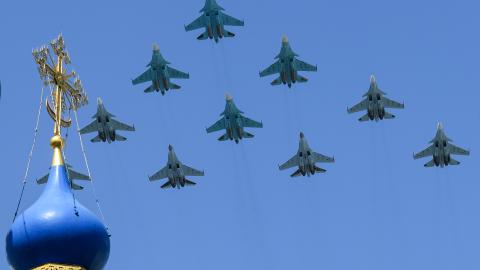Last week, while Secretary of Russia’s Security Council and former Defense Minister Sergei Shoigu was in Tehran, reports broke out that Russia had transferred Iskander short-range ballistic missile systems and Murmansk-BN electronic warfare systems to Iran. If confirmed, this transfer underscores the lengths Russian President Vladimir Putin will go to win his war against Ukraine.
With a range of around 310 miles and the ability to fire conventional or nuclear warheads, the Iskander is a prime component of Russia’s ballistic missile capability. Meanwhile, first deployed in 2014, the Murmansk-BN is a modern system, which will undoubtedly be an upgrade for Iran.
These transfers — along with the possibility of Iran having or soon getting its hands on Russian Su-35 fighter jets — clearly highlight the steep price in advanced technology that Tehran is extracting from Moscow in exchange for help with Ukraine.
And as Iran moves up the food chain in terms of what it can procure from Russia, the threat to U.S. interests and allies in the Middle East is expanding. For Russia isn’t only actively assisting Iran in hardening its defenses against future strikes, it’s also providing Tehran with advanced military technologies and cash from arms sales, further enabling the mullahs to sow discord and violence across the region and beyond.
The expanding military-to-military and defense industrial relationship between Iran and Russia is yet another facet of the ways in which Russia’s decision to launch its full-scale invasion of Ukraine supercharged the pace and scope of U.S. adversaries working more closely together.
Of course, Iran and Russia already had a strong defense relationship prior to February 2022. However, this primarily consisted of Tehran purchasing Russian arms. New developments have since shifted this paradigm, not only weakening Moscow’s ability to withhold higher-end technology from Iran but, in some cases, even forcing the country into the unusual position of seeking out Iranian technology.
Having seen Ukraine’s successful use of Turkey’s Bayraktar TB2 drones in the early stages of the war, Moscow turned to Iran to fill a gap in what was fast becoming a central component of the war — drone warfare. And over the last two years, drones have become the core element of the defense relationship between these two nations. Iran began transferring attack and surveillance drones to Russia in August 2022, and since that time, Moscow’s been deploying Iranian drones against Ukrainian targets in swarm attacks, seeking to overwhelm Ukraine’s limited air defenses.
Iranian drones can be produced cheaply and en masse, so even when they’re successfully intercepted, they extract an inflated cost if they’re shot down by expensive missiles that have lengthy production times. Despite their relatively small payload, they still pack a punch as well, causing damage to civilian homes, energy infrastructure and front-line forces. And as of the end of February, Russia had fired some 4,600 Iran-designed drones at Ukraine.
Powered by an engine design utilizing technology illicitly acquired from a German company, the Shahed-136, for example, can be built for $20,000 to $50,000 per unit. And though Iran forced Russia to pay a significant markup for these drones ($193,000), this expense is still only a fraction of the cost Russia would have had to spend to produce missiles like the Kalibr, the KH-101 or the Iskander.
Keen to further lower their per unit cost and expand the overall number of drones available for use, Russia has now purchased Iranian know-how and set up a factory for domestic production in its Tatarstan region as well. So, Russia now assembles Shaheds and produces many — though not all of — the components indigenously, while higher-end inputs for the factory, like engines, microelectronics and optics, are either produced in or sourced from China.
Moscow reportedly now has a goal of producing 6,000 of these drones per year by next summer. And more worryingly, there’s some evidence that Russian engineers have improved on certain aspects of their design, including coatings that make them less visible to radar.
In addition to utilizing teenage labor from a nearby school to assemble these drones, Russia’s also leveraging anti-Western propaganda, higher salaries, as well as relations with strongmen in places like Uganda to attract engineering talent from Africa to bolster its output.
In Putin’s quest for more killing machines, seemingly disparate threads have been woven together. And the challenges presented by the deepening ties between Moscow and Tehran — one borne out of a mix of necessity, convergence of interests and a desperate need for what the other has to offer — will remain with the West for some time.
Iran’s role in Hamas’ Oct. 7 attacks on Israel was in part a gift to Russia, to ease pressure on its forces in Ukraine and to introduce fissures in the Western alliance. As evidenced by this ongoing symbiotic defense relationship, Russia and Iran see the wars against Israel and Ukraine as indelibly linked — and we in the West would be foolish to compartmentalize them.
Enjoyed this article? Subscribe to Hudson’s newsletters to stay up to date with our latest content.



















